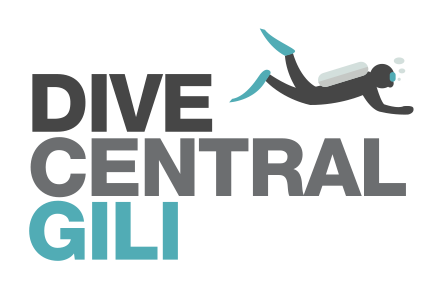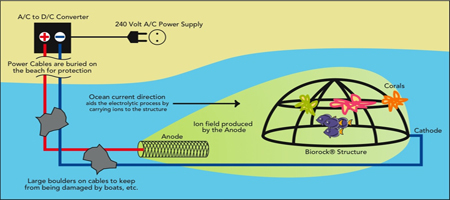Bio Rocks Rock!
There are many factors that have affected the growth of our precious coral reefs around the Gili islands. A rise in sea level, heatstroke, sewage, rubbish and over fishing have all been sadly aiding the deterioration of our reefs, causing marine life to become affected too.
Seeing some light at the end of the tunnel, the island of Gili Trawangan decided to fight back and to start to concentrate on restoring the reefs in the surrounding waters. Home to the second largest project in the world, it was local fishermen who kick-started some of the eco movements when they set up patrols to stop the dynamite fishing. Now boasting 63 Bio Rocks, hundreds of divers and snorkelers alike can enjoy the vast array of marine life directly off of our main beaches.
History - The Science Part
Sinking anything solid in the ocean will attract calcium carbonate. This is a key ingredient in coral and with just a little bit of science, humans were able to recreate coral reefs, almost identical to the ones that grow naturally.
In the 1974, marine scientist Wolf Hilbertz was researching seashells and coral to find out how they grow. He found that by passing an electrical current through seawater, the salty water electolyzes causing calcium carbonate to to combine with magnesium. Chloride and hydroxyl ions slowly form on the cathode and this eventually coats the electrode with a material almost as strong as concrete. Over time this material hardens further, growing and becoming stronger as long as the current flows as much as 5cm per year. It can even heal itself if it were to be damaged and due to it's high levels of dissolved oxygen it is particularly attractive to marine organisms Th super food for our coral reefs!
Hilbertz was originally planning to concentrate his work on building low cost structures for developing countries, his focus shifted (luckily for us!) to saving the ocean when he met biologist Tom Goreau in the 1980s.
The Bio Rock process uses such simple material that structures could be made t look like natural reefs, or like some around the Gili islands, a turtle or a manta ray! Small bits of broken coral could be attached to the structures and would happily exist, and even thrive there, due to the highly oxygenated, electrified material they were attached to.
Proof of this was seen in the Maldives during the 1998 warming. Less than 5% of the natural reefs survived. Bio rock reefs n the area showed that 80% of th coral there not only survived, but flourished. Pretty amazing stuff. A home grown reef system meaning that humans could start to rebuild some of the underwater rain forests that are so important to the eco-system.
Structures are anchored to the seabed and pumped with a low voltage electric current using an anode. An electrolytic reaction occurs causing mineral crystals naturally found in the water to be attracted to the structure, forming a coating. After a few days, the structure turns whitish as it becomes encrusted with minerals adding rigidity and strength. Electrical fields, plus the shade and protection offered by the metal/limestone frame, attract a wide range of colonizing marine life including fish, crabs, clams, octopus, lobster, and sea urchins.
The 2nd Largest Bio Rock Project in the world - Gili Trawangan
There are currently 127 Bio Rocks around the Gili islands and Lombok, making it the second largest project in the world (the largest being in Pemuteran, Bali). The Bio Rocks is a favorite dive site for every dive shop on the island. Delphine Robb,coming from France in 2005, is our very own island eco warrior. Coming to Gili to complete her PADI divemaster, Delphine ended up staying put and driving the many eco programmes that this island is lucky enough to have.
Delphine met Tom Goreau in November of 2005 at the first Bio Rock workshop. By the end of the presentation, Delphine had been enlisted. The following year Delphine ran the workshop herself and successfully signed up all of the major dive shops on the island. In return they would receive their very own Bio Rock right outside their own dive shop.
As well as helping to restore coral in the area, the bio rocks also help to prevent beach erosion, a massive problem around the small atolls of the Gili islands after the destruction of the natural reefs.
Delphine then looked at ways to make the electricity used more sustainable as using diesel generators was not so eco-friendly. The first tidal energy turbines were built to power the bio rocks, which gained huge support from major companies including Total and even Malaysian airlines who are planning to put in an airplane sculpture.
An ongoing Success
Students can now come to Gili to work on the project. Aimed at gap year students, people on career breaks and anyone interested in more than just a normal vacation. Volunteers can come along to the island and help out on new Bio Rock projects, work on maintaing existing ones or even sinking their very own brand new Bio Rock. Other activities include how to create and maintain a coral garden, learn about environmental threats and coral biology, and how to survey coral gardens.
Here at Dive Central Gili we offer our very own coral reef awareness course. Come and learn about how important the underwater rain forest is and how important it is to help rebuild and protect it all over the world.
Our sister company Trawangan dive are the main leaders of the Bio Rock project, working closely together with Delphine and the Gili Eco Trust. Come and help and join the project!




